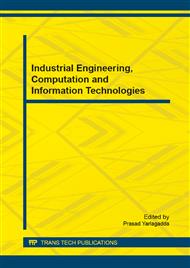[1]
Sanpechuda T, Kovavisaruch L, A review of RFID localization: Applications and techniques, In Poceeding: electrical Engineering Electronics, Computer, Telecommunications and Information Technology, 2008. ECTI-CON 2008. 5th International Conference on. IEEE, 2008, 2: 769-772.
DOI: 10.1109/ecticon.2008.4600544
Google Scholar
[2]
Woo S, Jeong S, Mok E, et al, Application of WiFi-based indoor positioning system for labor tracking at construction sites: A case study in Guangzhou MTR, Automation in Construction, 2011, 20(1): 3-13.
DOI: 10.1016/j.autcon.2010.07.009
Google Scholar
[3]
Muthukrishnan K, Lijding M, Havinga P, Towards smart surroundings: Enabling techniques and technologies for localization, Springer Berlin Heidelberg, (2005).
DOI: 10.1007/11426646_32
Google Scholar
[4]
Hightower J, Borriello G, Location systems for ubiquitous computing, Computer, 2001, 34(8): 57-66.
DOI: 10.1109/2.940014
Google Scholar
[5]
Kmarungsi K, Krishnamurthy P, Analysis of WLAN's received signal strength indication for indoor Localization fingerprinting, Pervasive and mobile computing, 2012, 8(2): 292-316.
DOI: 10.1016/j.pmcj.2011.09.003
Google Scholar
[6]
Kamisaka D, Muramatsu S, Iwamoto T, et al, Design and implementation of pedestrian dead reckoning system on a mobile phone, IEICE TRANSACTIONS on Information and Systems, 2011, 94(6): 1137-1146.
DOI: 10.1587/transinf.e94.d.1137
Google Scholar
[7]
Lee J Y, Yoon C H, Hyunjae P, et al, Analysis of Localization estimation algorithms for WiFi fingerprint-based indoor localization, The 2nd international conference on software technology. 2013, 19: 89-92.
Google Scholar
[8]
Keller J M, Gray M R, Givens J A, A fuzzy k-nearest neighbor algorithm, Systems, Man and Cybernetics, IEEE Transactions on, 1985 (4): 580-585.
DOI: 10.1109/tsmc.1985.6313426
Google Scholar
[9]
Cost S, Salzberg S, A weighted nearest neighbor algorithm for learning with symbolic features, Machine learning, 1993, 10(1): 57-78.
DOI: 10.1007/bf00993481
Google Scholar
[10]
Kleeman L, Optimal estimation of position and heading for mobile robots using ultrasonic beacons and dead-reckoning, Robotics and Automation, 1992. Proceedings., 1992 IEEE International Conference on. IEEE, 1992: 2582-2587.
DOI: 10.1109/robot.1992.220053
Google Scholar


